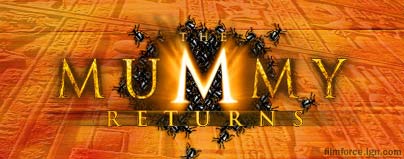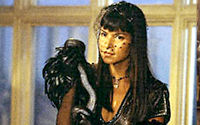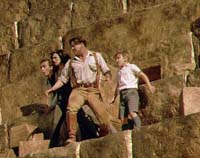
| Bad Astronomy |
|
|
|
BA Blog
|
|
Q & BA
|
|
Bulletin Board
|
| Media |
|
|
|
Bitesize Astronomy
|
|
Bad Astro Store
|
|
Mad Science
|
|
Fun Stuff
|
| Site Info |
|
|
|
Links
|
| RELATED SITES |
| - Universe Today |
| - APOD |
| - The Nine Planets |
| - Mystery Investigators |
| - Slacker Astronomy |
| - Skepticality |
Buy My Stuff

Keep Bad Astronomy close to your heart, and help make me
filthy rich. Hey, it's either this or one of those really
irritating PayPal donation buttons here.
Review: The Mummy Returns


|
Bad ASPtronomy? |
Bad:
The astronomy starts almost at the end. Our Heroes are running after
the Bad Guys who have kidnapped their Precocious Kid. They are chasing them
in... a dirigible (of course!). We see them flying across the
full Moon. A few nights later, we see them flying across... the full Moon.
Good:
The phase of the Moon is probably the single most abused astronomy
idea in movies (besides sounds in space).
The Moon goes through phases as it orbits the Earth.
The phase changes every night, and the difference over even two nights is
pretty clear. It's possible, just, that over three nights the Moon
can be almost full, then full, then a little past full. But usually
the Moon is very different over the course of that much time.
Really, the phase should have changed quite a bit during the chase.
Bad:
At night, we clearly see the characters floating above
the countryside, the full Moon and thousands of stars visible
in the background.
Good:
Shades of
the Moon Hoax! Actually, you would not be able to see the stars
during these scenes. The full Moon, which evidently is always
full in the movie, would swamp them out. It's really hard to see even
bright stars when the Moon is full, because the tremendous light of the
Moon overwhelms them. You can see this for yourself, and I urge
you to! At the very least, you'll go outside and watch the moon. ;-)
Actually, the full Moon is so bright that astronomical observatories split the month up into what they call "dark time" (when the Moon is either not up at night or a thin crescent) and "bright time" when the Moon is up most of the night. Astronomers looking for very faint objects try to get the dark time, and so of course there is heavy competition for it.
Anyway, seeing stars in movies is a bit of a pet peeve of mine.
It's rarely done correctly.
In many shows, including "Star Trek", unfortunately, it
is common to see stars out a window even if the room is brightly lit.
This won't work very well! Even if the glare of inside lights reflected off the
window doesn't swamp the stars, your eyes will be adjusted for the brightly
lit room, and the stars will be almost invisible. Only the
brightest stars will be visible, and the vast majority will
be too faint to fight such
luminance. This sort of thing crops up in commercials, movies and TV
shows. It isn't accurate, sure, but more than that it doesn't look
right. You can tell the image is faked, like when they use reflectors
to make someone lit from the wrong side in a sunset scene. You may not
be able to figure out what's wrong, but your brain knows
it's wrong.
[Note added May 24, 2002: I had originally said seeing stars out the
window was impossible, but had enough email from people to make it clear that
although it's hard, it's possible, so I amended the above paragraph to, haha,
reflect that.]
Speaking of which...
 Bad:
Bad:
In the nearly final climax of the movie (the movie climaxes a
lot) Our Hero Rick O'Connell must get his Precocious Kid into the
Golden Pyramid before the rising Sun touches him, or else his
Precocious Kid will
get a free ride to the Underworld. Running, O'Connell carries
his
Precocious Kid towards the pyramid. We see the light of the rising Sun
as a line across the movie screen, sweeping after Our Hero, and
he barely is able to outrun it and jump into the pyramid saving,
his Precocious Kid.
Good:
The line that divides day and night is called the "terminator".
That line appears to sweep across the Earth because the Earth rotates.
Since the Earth rotates once every 24 hours, the ground speed of the
terminator is about 1600 kilometers per hour (1000 miles per hour)
at the equator, which is roughly where this movie takes place.
You might think then that the movie got this wrong by having the
shadow line move at perhaps 15 or 20 kph.
However, what we are seeing is not the terminator line. The scene takes place in a valley surrounded by mountains. What we are seeing is actually the shadow of the mountains moving across the ground. This is a subtle but crucial difference.
The speed of the shadow of an object depends on how fast the Sun is moving across the sky, how tall the object is that casts the shadow, and how high up the Sun is. Think about it. At sunset, the shadows appear to move pretty fast, and in a few minutes you can see them lengthen appreciably. My own shadow can lengthen by as much as 10 meters in 20 minutes. At noon though, when shadows are short, in an hour it only grows a fraction that much.
I won't do the math here (click here to see how I calculated this) but I found that, assuming the mountains in the movie were 1 kilometer high (a rough guess) and 10 kilometers away, their shadow will sweep across the ground at about only 7 kilometers per hour (5 miles per hour) just after the Sun clears the peaks. That's about what the movie showed! So instead of this being Bad Astronomy, it's actually Good. [Note: the day after I originally wrote that I realized I did the math a somewhat incorrectly; I had 40 instead of 7 kph. I have fixed it here and I show my math at the link above.]
I'll note that Major Film Critic Roger Ebert (whom I'll note I actually like a lot, and I'll also note we agreed about liking Red Planet) made this same mistake in his review of this movie; he assumed the line was the day/night terminator and said the line wasn't moving quickly enough. Ironically, if anything the line is moving a bit too fast.
But wait! We're not done. Our Hero is carrying his PK west, away from the rising Sun to the east. As the Sun rises, it lights up tall objects first and the light works its way down as the Sun rises. So instead of seeing the shadow line moving along behind Our Hero, he should actually see it light up the top of the pyramid and move down like a closing dungeon door on the base of the pyramid. So the movie still had it backwards. They would have had it right had the Sun been setting, but not rising.
This is another case where the scene looks wrong, though you may not know exactly why. And I think seeing the shadow line moving down the pyramid would have been cooler, and more dramatic. When will Hollywood know to call me before they make these movies? ;-)
[Note added August 22, 2001: Many Bad Readers have emailed me saying that the shadow line in the movie should actually not be very well-defined. This is correct. Since the Sun actually has a finite size in the sky, part of it can be behind the mountains while part peeks above them. That makes shadows fuzzy, without a well defined edge. I knew while watching that scene that something else was wrong, but couldn't put my finger on it. My thanks to the legion of people who finally solved this one!]
Like I said, the movie was fun, though it could have been better. The Bad Astronomy in it was minor. Of course, when you are dealing with mummies, armies of the undead, magic bracelets and reincarnation, all scientific bets are off.
Maybe the Mummy III will have better astronomy, if it has any at all. And if you think they won't make a second sequel after this one made $70 million opening weekend, maybe you need to have your brain placed in a canopic jar.
[Note added June 4, 2001: I have been told by a couple of Egyptologists that the brains of the pre-mummy people were not saved in canopic jars; the brains were discarded as useless tissue. Perhaps the ancient Egyptians knew something we don't.]
Wanna see more? Then try these links:
-
The Mummy's Official Website
-
The Brendon Fraser Film Consortium
-
The real scoop on Imhotep
- Do you dare read about the Mummy's Curse?
|
|
 |